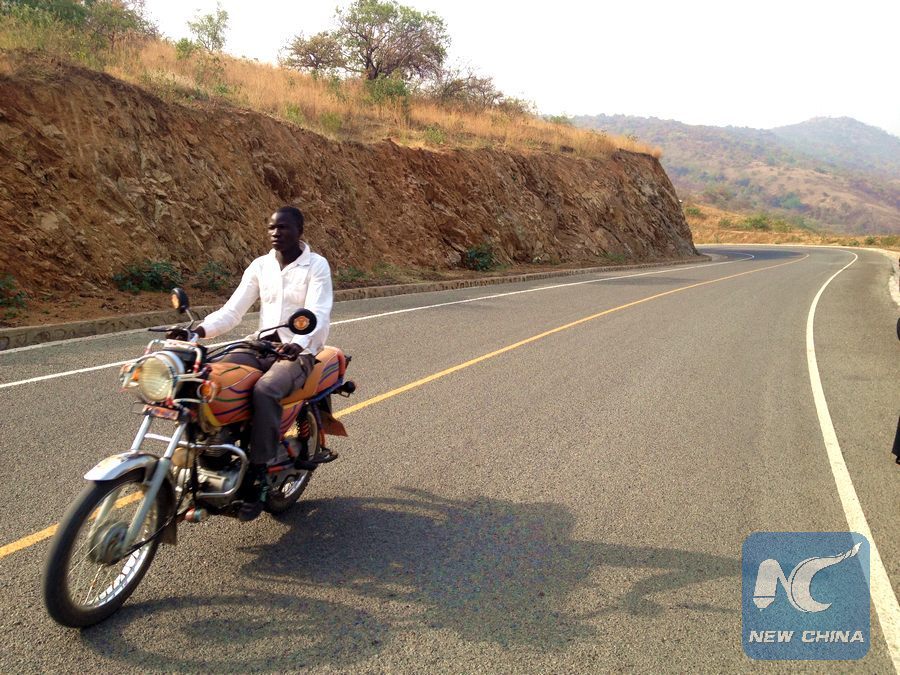
A man rides a motorcycle in Buhuka, Uganda, on Feb. 26, 2016. (Xinhua)
by Ronald Ssekandi, Yuan Qing
KAMPALA, May 17 (Xinhua) -- As East Africa's third largest economy after Tanzania and Kenya, Uganda is facing a myriad of challenges that are slowing down its growth from the projected 5 percent to about 3.5 percent, according to the International Monetary Fund figures issued on Tuesday.
The Ugandan government has now announced short and medium plans to revitalize the struggling economy.
The country is prioritizing the development of the agriculture sector in a bid to resuscitate the economy. About 70 percent of the country's population derives its livelihood from agriculture.
David Bahati, minister of state for finance, this week told reporters that the government has set aside 186 billion shillings (52 million U.S. dollars) to boost irrigation.
The prolonged drought that the country faced over the past year is largely blamed for the slow growth.
Bahati is optimistic that once the irrigation system is in place, drought would not be a factor affecting the economy.
He said over 80 factories are going to be set up across the country to manufacture solar powered irrigation pumps.
In the short term, the government is urging farmers to use the traditional drip irrigation to fight drought.
"We can not continue depending on natural weather if we are to benefit from agriculture," Bahati said.
The government is also going to set a side 260 billion shillings (72.2 million dollars) that will be used to purchase seedlings that will be distributed to farmers, according to the ministry of finance.
In its industrialization policy, the government is encouraging more agro-processing factories to add value to the agriculture produce.
According to Uganda Investment Authority, a state-owned agency charged with attraction of investors, the government is going to set up over 20 industrial parks across the country in the next three years.
The industrialization move is aimed at reducing money spent on imports. Ministry of finance figures show that Uganda imports goods worth 1.1 billion dollars from India alone. Its imports from China are worth 870 million dollars annually.
"We will be focusing on building factories to produce things we have been importing but also push for exports," Bahati said.
Uganda is optimistic that as the region stabilizes security, its exports will increase. The conflicts in neighboring South Sudan, eastern Democratic Republic of the Congo and Burundi have affected the country's exports.
Government figures show that the fighting in neighboring South Sudan has forced Uganda's exports to the country to drop to 200 million dollars from 700 million dollars annually.
According to the finance ministry, the government plans to exit borrowing from the domestic market in a bid to lower the cost of credit.
Interest rates charged by commercial banks go to over 20 percent, according to the central bank, Bank of Uganda, figures.
Bahati argues that the government will now resort to borrowing from external sources like World Bank, China Export and Import Bank, among others. He also notes that the government that will set aside 126 billion shillings (35 million dollars) to recapitalize the Uganda Development Bank.
The move is expected to bring down the cost of borrowing to between 10-12 percent.
In a bid to increase domestic revenue, the government is stepping up the development of its oil and gas sector.
The government has anticipated to start getting revenue from its oil by 2020. It has set aside 900 million dollars to develop roads and construct an international airport in the oil region. Uganda has over 1.6 billion barrels of commercially viable oil in the western part of the country.
The country's President Yoweri Museveni has argued that the oil revenue will be critical in fast tracking the country's infrastructure development.
With these measures, the government is optimistic that it will revamp its economy to a steady growth of 6 percent per year in the next three to four years.

